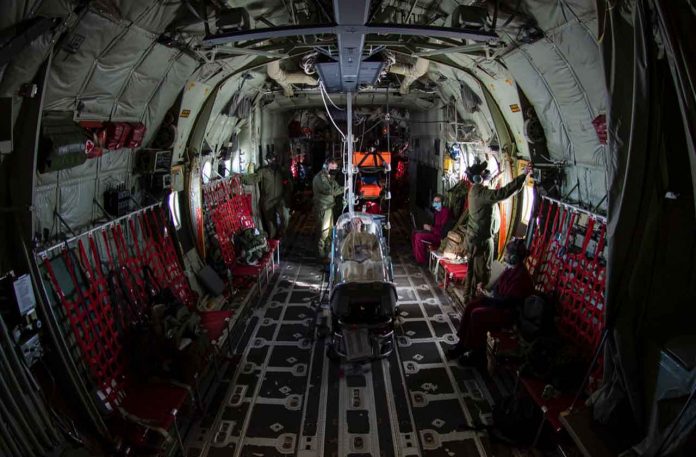
OTTAWA – COVID-19 Update – With the world still dealing with the threats posed by the COVID-19 pandemic, the Royal Canadian Air Force (RCAF), in collaboration with Canadian Forces Health Services Group, is implementing a new bio-containment capability for the transport of infectious patients.
Called the Aeromedical Single Isolation Bio-containment Unit (ASIBU), this new capability allows for the safe isolation of patients thought to be contagious while allowing medical experts to provide direct treatment. In effect, it allows medical staff to treat patients with virtually zero possibility of transmission of infection in either direction, all while being transported in an aircraft.
“The ASIBU capability will allow us to safely and effectively transport infectious patients by air, while our medical personnel provide treatment,” says Major Marilou Beaucage, the senior Nursing Officer with the Canadian Armed Forces (CAF) Aeromedical Evacuation (AE) Flight at 8 Wing Trenton, Ontario. “Our mandate is to provide quality health care in the air, at home and abroad. Caring for patients with an infectious disease adds a significant level of complexity; this new capability is an extra tool to help us bring patients back home or to the appropriate level of care safely.”
Measuring approximately two metres long by one metre wide, the ASIBU is a durable, reusable “capsule” for a single patient with sealed ports on its sides. This enables health care providers to access the patient, while protecting those outside the capsule from exposure to potential infectious pathogens. Because of its relatively small size, the ASIBU can be used in most of the RCAF’s aircraft, including the CC-177 Globemaster, CC-150 Polaris, CC-130 H/J Hercules, CP-140 Aurora, CH-147F Chinook, CH-149 Cormorant and the CH-148 Cyclone. The CC-130J Hercules will be the primary platform by which the ASIBU will be employed.
A total of 15 ASIBUs (trademark EpiShuttle) were ordered and have been delivered, with one going to each of the RCAF’s five primary search and rescue squadrons across the country. The remaining ten units will stay at 8 Wing Trenton, which will be the operational focal point for the ASIBU. This includes a “standby” allotment of ASIBUs that are ready to evacuate up to four infectious patients on a single CC-130J Hercules flight.
The RCAF is currently working with the 1 Canadian Air Division Surgeon and the CAF AE Flight on the operational implementation of this new capability, which includes the development and testing of procedures and training programs. The expectation is that the ASIBU will be fully operational in early 2021.
The ASIBU is just one of the new bio-containment capabilities that the RCAF is investing in, with the aim of providing a cutting-edge ability to conduct safe aeromedical evacuation of potentially infectious patients. In addition to the ASIBU, the RCAF is also procuring the Aeromedical Bio-containment Evacuation System, which is a large, sea-container-sized containment unit, and Disposable Isolation Single Bio-containment Units, which are essentially lighter, one-time-use versions of the ASIBU. All told, the total investment is valued at approximately $7.3 million.
“The RCAF is on the path to becoming much more agile in the safe aeromedical evacuation of infected patients,” says Lieutenant-General Al Meinzinger, Commander of the RCAF. “These procurements will provide the RCAF with the most advanced equipment commercially available to build a capability for now and for years to come.”
The global coronavirus pandemic makes this new capability timely, but the RCAF also has its eye on more long-term requirements. With serious outbreaks of Ebola in Africa in recent years, and the ever-present possibility of yet another pandemic of influenza or other infectious diseases, these new capabilities are key to ensuring the RCAF’s ability to provide the Government of Canada with effective options for safe aeromedical evacuation at home and abroad.






